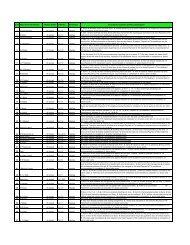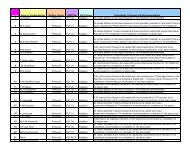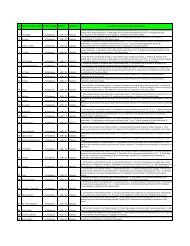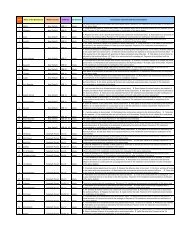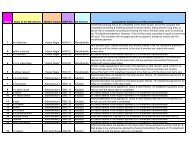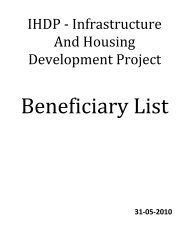Project Appraisal Document - IHDP
Project Appraisal Document - IHDP
Project Appraisal Document - IHDP
- No tags were found...
Create successful ePaper yourself
Turn your PDF publications into a flip-book with our unique Google optimized e-Paper software.
choose to. The District Secretariat would ensure that Government environmental guidelines areadhered to in the extraction of resources.Component Two: Water, Sanitation and Environment Mitigation (US$ 16 million)18. Background: The Puttalam district is situated on the north west coast and dry zone of SriLanka. The annual rainfall of 15 to 30 centimeters is largely limited to the months of Novemberand December. The main source of drinking water is situated in a series of deep and shallowaquifers. The quality of water in these aquifers ranges widely depending on location. Studiesindicate that ground water is often contaminated with nitrates in areas where intensive agriculturetakes place. The excessive use of groundwater for agriculture and prawn farms has led to a salineintrusion in other areas. The inappropriate design of latrines leads to the bacteriologicalcontamination of ground water in several refugee camps. The average depth of most shallowwells ranges from 5 to 10 meters although in certain places ground water can be accessed only atvery deep levels. The availability of safe drinking water is a serious concern in light of thesefactors. Several sites are located on sand dunes, marshy and flood prone areas.19. The refugee camps in Puttalam were initially anticipated to be of temporary duration.There was no investment in basic infrastructure. IDA support for drinking water, sanitation andenvironment management is intended to upgrade the refugee camps into sustainable habitat andintegrate them with the surrounding communities given that the IDPs are now likely to remainthere. The PHP would include water and sanitation in certain adjoining and vulnerable non-IDPvillages to mitigate non-IDP resentment at the transfer of resources to IDPs.20. Water: The National Water Supply and Drainage Board (NWSDB) undertook a conceptfeasibility study to map groundwater sources, report on water availability, water quality, sourceyield, suitability of various methods of excreta disposal and the cost estimates for water supplyand sanitation. It listed refugee camps that can be covered by a stand alone water supply andsanitation systems, and camps that need to be clustered for technical and cost reasons. Based onthis study, pumping sites would be strategically located within a demarcated zone and clean waterdistributed to participating refugee camps and non-IDP villages through a system of storage tanksand pipes, or pumped through tube wells. The type of scheme would depend on location andground water condition.21. The PHP would provide drinking water to 13,584 IDP families and 3,291 non-IDPhouseholds. This adds to a total of 16,875 households. The IDP recipients would include thosewith permanent housing. Non-IDP recipients would include those living in source areas, en-routeof the piped water schemes and in villages without drinking water adjacent to identified refugeecamps. This is estimated to cost US$ 12 million. It includes provision for technical assistance,project management, supervision, taxes and physical/price contingencies 15 . The NWSDB wouldprepare engineering drawings and bid documents. The PPU would invite bids.22. The supply of drinking water would be modeled on the ongoing IDA-assistedCommunity Water Supply and Sanitation <strong>Project</strong> (H. 0350) in the North West Province. The PHPwould be in conformity with the Government’s National Rural Water Supply and SanitationProgram (RWSS). See Annex 4 for more details. Stand posts will be considered the basic servicelevel; however households opting for a higher service level such as yard taps and/or house15 UNICEF support for drinking water would include refugee camps participating in the IDA-financed project andadjacent host communities.9



